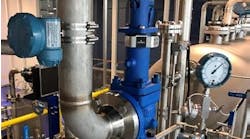Here we provide the key points for Part 2 of my recent AIChE St. Louis Section course sponsored by MYNAH Technologies. The focus here is on improving the performance of compressors, jackets, heat exchangers and batch operations and the key role of valve position control (VPC).
The improvements typically can be done by the selection of PID options, pairing of variables, and the addition of PID controllers and simple standard function blocks. The configuration improvements can often be done and tested in a few days.
My recent AIChE St. Louis Section short course sponsored by MYNAH Technologies “Control Strategies to Improve Process Capacity and Efficiency” is viewable in three parts, each video about one hour in length on www.MYNAH.com by selecting “Videos” at the bottom of the webpage or clicking on the following direct links to each video:
Part 1: Process Dynamics Review, General PID Solutions, Feedforward and Ratio Control, Steam Systems
Part 2: Compressors, Jackets & Heat Exchangers, Valve Position Control, Continuous and Batch Control
I am exceptionally proud of this course. It is an updated concise view of what I have learned to be truly important for achieving significant benefits from process control. Last month we covered Part 1. Here are my Part 2 Key Points that provide a synergistic understanding with the viewing of the videos:
Part 2 Key Points
2-1: The best compressor setpoint for compressor suction flow to prevent surge and maximize efficiency is a setpoint curve on the plot (compressor map) of compressor Pressure Rise versus Suction Flow that is parallel to the surge curve.
2-2: The offset must provide enough time for the surge control system to react and prevent crossing of the surge curve and ideally be near the center of the ellipses for compressor efficiency.
2-3: The surge curve coincides with the points of zero slope on the characteristic curves for different speeds or inlet vane positions signifying the loss of negative feedback in the process given by a negative slope of characteristic curves (processes without negative feedback are inherently unstable).
2-4: To the left of the surge point, the slope of the characteristic curve becomes positive creating positive feedback causing the operating point to jump to a point on the characteristic curve that has negative slope and negative feedback. Unfortunately, this is typically a negative suction flow. The operating point then walks along the negative slope characteristic until it reaches the positive slope characteristic at which point it jumps to a positive flow at a previous operating point in its approach to the surge curve. The operating point then moves toward the surge point repeating the cycle.
2-5: The precipitous drop in flow can occur in 0.03 seconds and the surge cycle period tends to be 1 to 2 seconds (faster for the experimental setup in presentation). This incredibly fast jump to negative flows and back to positive flows is extremely disruptive to downstream users and potentially damaging to the compressor. Surge causes high radial vibration and high dynamic axial thrust forces eventually damaging the journal bearing and thrust bearing. There is can be a consequential loss in compressor efficiency at all operating conditions from successive surge cycles. For axial compressor the damage can be particularly severe. A large high speed high pressure compressor I had to protect could destroy its million dollar rotor in a matter of seconds.
2-6: The suction flow controller whose setpoint is a curve parallel to the surge curve must come off of its output limit in time to prevent reaching the surge curve. This typically must occur before the operating point crosses the surge setpoint (suction flow drops below its setpoint) unless the setpoint is far to the right of surge curve. Since reset action tends to try to keep the surge valves closed until crossing setpoint, intelligent tuning must provide more proportional than integral action and logic to specify when the surge valve starts to open is often needed.
2-7: A feedforward of user feed flow can help preemptively position the surge valves (not shown on slide). Since the surge valves should have linear installed characteristics, this feedforward can be simply added to the suction flow controller if the feedforward signal is scaled in terms of surge valve capacity similar to what was stated for the steam header letdown valves. A lead-lag may be necessary as dynamic compensation to make sure the feedforward correction to the compressor suction flow does not arrive too soon or too late.
2-8: External reset feedback and analog output block setpoint rate limits can provide directional move suppression to give fast opening and slow closing surge valves without retuning the surge controller.
2-9: An open loop backup is needed to help prevent the start of surge and the recovery from surge. The surge phenomena and cycles are too fast and confusing to rely on feedback control. The open loop backup computes the rate of change of compressor suction flow to predict a crossing of the surge curve at least one deadtime into the future. A variable deadtime block is used to provide the desired signal to noise ratio in the prediction. See the 6/28/2012 Control Talk Blog “Future PV Values are the Future”
2-10: The controller execution time must be 0.1 seconds or faster, the transmitter damping time constant must not exceed 0.2 seconds and valve 86% response time must be 2 seconds or faster.
2-11: Fast valve response time requires backlash and resolution limits of 0.2% or better, a sensitive positioner and actuator with volume boosters on the positioner output(s) to the actuator with booster bypass valve(s) opened just enough to prevent oscillations. For more on how to achieve good valve response see the March 2016 Control magazine article “How to specify valves and positioners that don’t compromise control” and the associated white paper “Valve Response – Truth or Consequences”.
2-12: A valve position control (VPC) can smoothly optimize the compressor setpoint by pushing the largest opening of user feed valves to their maximum throttle position. External reset feedback and setpoint rate limits can provide directional move suppression to provide a gradual optimization with a quick getaway for abnormal conditions.
2-13: See the May 2016 Control Talk Column “Finer points of compressor control” for more details on the many challenges of compressor control.
2-14: A deadtime block can account for the transportation delay to synchronize jacket or coil inlet temperature with the outlet temperatures to compute the rate of cooling or heating to provide an inferential measurement of reaction and crystallization for batch and continuous operations.
2-15: Constant jacket or coil recirculation flow eliminates increases in process gain and dead time at low cooling or heating rates providing better tuning and preventing a burst of oscillations at low production rates.
2-16: Jacket or coil inlet temperature control offers faster correction of jacket utility temperature disturbances by seeing these disturbances before they enter jacket or coil. Limits can be placed on inlet temperature setpoint to prevent cold and hot spots.
2-17: Jacket or coil outlet temperature control reduces process noise by allowing time for more mixing and changes in phase (bubbles to condense and droplets to vaporize). Outlet temperature control can help see the start of a runaway condition sooner.
2-18: Manipulation of heat exchanger bypass flow for jacket or coil temperature control provides a faster secondary loop in the cascade control of vessel temperature to jacket or coil temperature. A VPC can increase the heat transfer coefficient and extend the rangeability of jacket or coil temperature control by minimizing the exchanger bypass valve position.
2-19: Steam injection heaters instead of split ranged operation of steam and coolant valves can eliminate the split range discontinuities and changes in phase providing much faster and smoother jacket or coil temperature control.
2-20: For heat exchangers in recirculation lines, the manipulation of the heat exchanger bypass flow for recirculation temperature control provides much faster initial response and separation of the self-regulating response at the exchanger and the integrating response from the vessel. A VPC can increase the heat transfer coefficient and extend the rangeability of recirculation temperature control by minimizing the exchanger bypass valve position.
2-21: The feed rate of continuous and fed-batch reactors can be maximized by a VPC.
2-22: External reset feedback with fast down and slow up setpoint limits on reactor feed can provide a directional move suppression enabling a gradual smooth optimization and a fast correction for abnormal conditions.
2-23: An enhanced PID for VPC developed for wireless and analyzers can ignore limit cycles in valve.
2-24: Coordinated ratio control of continuous and fed batch reactants by the use of setpoints with the same setpoint filter minimizes upsets to stoichiometry from changes in production rate created by VPC.
2-25: The distinguishing characteristic of a batch operation is a closed liquid discharge valve during processing causing an integrating response in composition, pH and temperature.
2-26: Fed-batch reactors have simultaneously PID controlled reactant flows and are for this reason sometimes called semi-continuous. However, the closure of the liquid discharge valve causes the same integrating response as traditional batch where reactants are sequenced.
2-27: Level and residence time control are not applicable to batch reactors.
2-28: Continuous reactor composition control techniques are applicable to fed-batch if the controlled variable is converted to a batch profile slope, which creates a steady state not seen before translation.
2-29: Traditional batch and fed-batch reactors can be held until a reactant is depleted whereas some of the reactant is in the discharge flow of continuous reactors in order for the reaction to continue.
2-30: The use of a deadtime block to create a inferential measurement of conversation rate from batch slope is useful for not only PID and Model Predictive Control of conversion rate but also for prediction of batch end points enabling detection of when a batch is complete and making economic decisions for the tradeoff between increasing yield and reducing batch cycle time.
I will provide Key Points of Part 3 concluding this series next month. Until then live large by process control improvement to advance you, your company and our profession.




